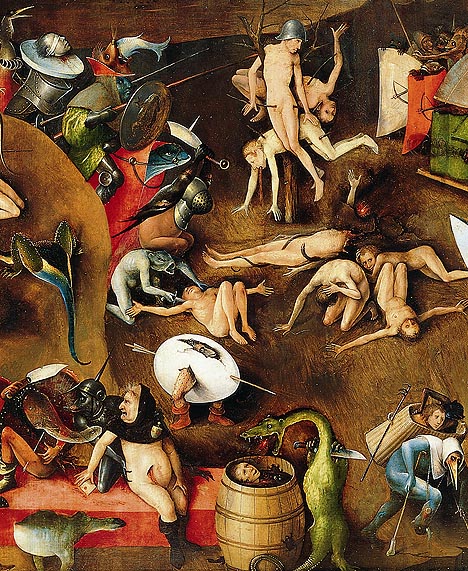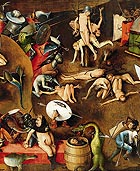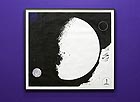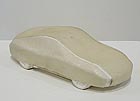
translated and summarized by: Liz Wollner-Grandville,
English summary April 6 - 13
Gemäldegalerie der Akademie der bildenden Künste Wien: Heaven & Hell – The early panel paintings in the Paintings Gallery
See - the good is so close
Go there and take a look
Another Viennese museum is showing 40 Gothic and Renaissance panel paintings, but with a different focus: the Paintings Gallery of the Academy of Fine Arts presents a superstar with Hieronymus Bosch’s “Last Judgement” .
A large part of the Paintings Gallery will remain closed until spring of 2010. But there is a fine exhibition on the Bosch-Triptych focusing on the topic “Heaven & Hell”, and presenting the different styles used by Old Dutch, German, and Italian schools of art.
Works, which were created during the same era, could not be more divergent if you compare Antonio da Fabriano’s “Coronation of Mary” (1452 – replica of Gentile da Fabriano) and Dierk Bouts (1450) work on the same topic. While the Tuscan Maria is painted on a golden background, in Gothic tradition, the colour of the heavenly Jerusalem, the younger (!) painting from the North, is clearly divided into an inner and outer space and emphasizes the materiality of objects. However, one aspect that is not applied yet is the vanishing point.
Hans Baldung Grien’s “Rest on the flight to Egypt” is, of course, also shown at the exhibit. Among the profane paintings one can find Lucas Cranach the Elder’s “Lucretia”, and “Queen Tomryi’s with the Head of Cyrus” by Michael Coxie.
The new exhibition level
The exhibition space on the first floor is currently being refurbished. A media room, a foyer that will join the two new rooms with the gallery, an elevator, a shop and a cloakroom will be installed, and the paintings and etchings will be relocated underground. Director Schmidt-Wulffen’s concept includes the transformation of the Paintings Gallery into a museum offering lectures.
By Maria-Gabriela Marinkowic
Gemäldegalerie der Akademie der bildenden Künste Wien
1010 Vienna, Schillerplatz 3, until 31.07.09
www.akademiegalerie.at
layr:wuestenhagen contemporary: Nick Oberthaler – The lost and found sky
Therein time and eternity
In his current exhibition at Layr Wüstenhagen, Nick Oberthaler presents an entire range of references: Romanticism, Nationalism, the painter’s gesture, existential philosophy, rebellious youths – all of this is found in his paintings and sculptures. And it is never boring – everything remains, postmodern, in abeyance, never becomes too distinct. He quotes Soeren Kierkegaard: “The moment is the ambiguous (condition) in which time and eternity touch one another” – indeed, without confirming this dramatic assertion, he lets the character arrays hang in a black space, just like the planet, surrounded by circles. In one of them an athletic body stretches towards the sun, obviously a classicist sculpture; it is difficult to say if it is ideologically contaminated.
In other works by Oberthaler, girls in traditional costumes and sturdy fellows leap around in front of abstract brush strokes - and even if the origin of these newspaper clippings is not apparent, it is obvious that they originated during the Nazi-era. The circle closes, if one considers the National Socialist’s weakness for everything romantic as well as their thoroughly calculated and tightly organized drills of youngsters. But Oberthaler is not trying to make a political statement – a cast of his forearm, which is heroically holding onto a staff, he makes fun of leftist revolutionary rhetoric as well as gestural painting. “Where rebellion and outrage degenerates to being staged, where youth becomes an empty gesture and deceives our own sensitivity like looking into a mirror”, is inscribed onto one of his paintings. But despite its density, Oberthaler’s (formally convincing) exhibition leaves enough breathing space.
By Nina Schedlmayer
layr:wuestenhagen contemporary
1010 Vienna, An der Hülben 2, until 30.04.09
www.layrwuestenhagen.com
Bucerius Kunst Forum GmbH: Matisse. People, Masks, Models
Art is beautiful, but it’s a lot of work
One would think that famous modern painters have already been presented in many different – audience attracting – ways, especially since the invention of Blockbuster exhibits. But surprisingly, portraits by Matisse have been more or less neglected – both by art historians as well as international exhibition venues. But now the Bucerius Kunst Forum in Hamburg is displaying, with its proven quality, a small, precise show with high-class works of Matisse’s portraits. This lets one discover an artist, who does not have any of the clichés, which have been attributed to him.
At long last, the salacious prejudice stating that the artist often made his models to mistresses is rectified. His models were oftentimes wives of friends and family members, including his daughter Marguerite. And even if one is alarmed to hear that he tended to compare the act of painting with an act of violence or even rape, this must, first and foremost, be put into perspective with references made by other Avant-garde artists, in which murder, pillage and other similarly destructive fantasies played a self-empowering role; and second, Matisse, knew how to sublimate the aggressive impulse by subjugating it to his idealistic perception of art.
This brings us to the second cliché, which the exhibition attempts to rectify: Matisse is not only a superficial decorator, an attribute often made especially in comparison to this rival Picasso. Instead, he is perceived as someone who forces reality into the corset of his imagination. As a painter who increasingly abstracts from the first natural impression – with the help of role models such as antique sculptures, Russian icons or primitive idols, - he finally leads his portrait into the eternal kingdom of art. This may be the reason why his portraits can at times have the effect of being rather detached. Matisse is not nearly as interested in the expression of the person being portrayed, but much more in the expression of his own confrontation with that person. That is why he, who according to a witness of his time was “addicted to new faces”, knew how to strategically implement his portraits - especially if his work was once again in a transitional phase, this was a strategy to prove himself and his talent. And he was more than capable of doing so.
By Peter Kunitzky
Bucerius Kunst Forum GmbH
20095 Hamburg, Rathausmarkt 2, until 19.04.09
www.buceriuskunstforum.de
Galerie Krinzinger: Gottfried Bechtold – Residue
Close companion: fast car
A Porsche is a car through which the financial potential of its owner become visible – both its price as well as its engine power make it to a fetish of the capitalistic “survival of the fittest”.
Gottfried Bechtold’s obsession is distinct and manifests itself in the current exhibition “Residue” at the Gallery Krinzinger. The elaborate production process utilizing concrete for the creation of eleven Porsche 11-clones (“Elf elf”, Bregenz 2006) is affectionately illustrated in an ORF film. The protective cover supplied by the car company for preserving the lustre and softening the characteristic silhouette, presented an exceptional sculptural challenge.
Aesthetic black-and-white photographs of two bearded men, each standing alone next to a Porsche, narrate their careful approach and detachment to the object, which is conveyed through the distance between the picture margin and the protagonists. There are also a few milk carton sized casts made of different materials and colours, with and without the characteristic protective cover.
All of Bechtold’s works are neatly arranged. Listening to Bechtold (in the ORF film) mention that he views the world with the eyes of an engineer, one could reflect that this might be a kind of Gothic high-tech workshop romance - with a cathedral-like seriousness and a calculated usage of a condom. For Bechtold, the phenomenon obsession attains the aspect of accurate and gentle relevance - that being a potential, that one cannot easily hear when listening to Porsche-sounds on the street.
By Gesche Heumann
Galerie Krinzinger
1010 Vienna, Seilerstätte 16, until 30.04.09
www.galerie-krinzinger.at
Mehr Texte von translated and summarized by: Liz Wollner-Grandville


 Teilen
Teilen




